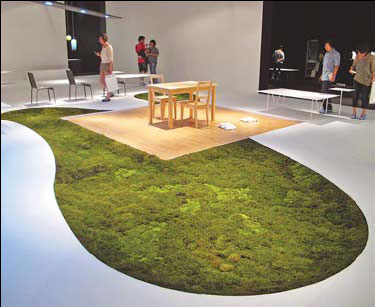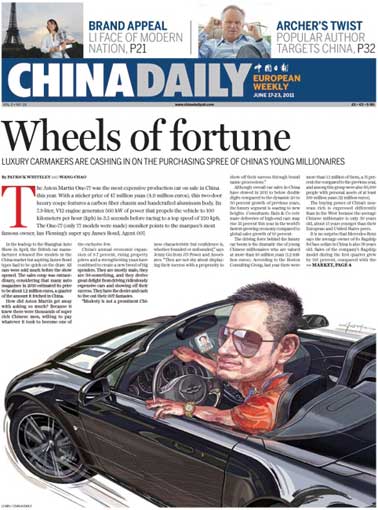Art
Design for the future
Updated: 2011-06-21 07:59
By Zhang Zixuan (China Daily)
|
Japanese flower artist Makoto Azuma's work, Time of Moss, uses the TERRAMAC technique to turn indoor areas into a mossy wetland. Zhang Zixuan / China Daily |
After three year's of preparation, the first solo exhibition of a Japanese master of design, Kenya Hara, has finally been unveiled at the Beijing Center for the Arts.
Designing Design is a retrospective of Hara's career and serves as a reference point for Chinese design, as it meets the challenge brought by globalization and urbanization.
The exhibition, which runs until July 15, divides a 2,000-square-meter space into three sections Aspects of Design, Art Direction for MUJI and Exhibiting Exhibitions. "The three sections present the process of my thinking in the most natural way," Hara says.
The first section, Aspects of Design, which Hara describes as "an attempt to ruminate over the issues", presents a cross-sectional review of his previous works, such as book covers, packages and posters.
In the series of posters, calendars and concept books Hara designed for the 2005 World Exposition, held in Japan, he used images of fish, monkeys, trees and other natural elements Japan is known for to deliver the message "Into the Pre-existing Nature", which was the theme of the Expo 2005.
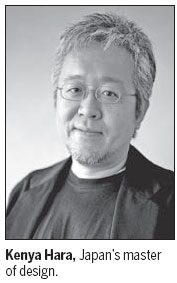
Also featured in the section are Hara's designs from 1999 and 2000, such as water and wine bottles and rice bags. They are created in the simplest of shapes and combined with elements from Japanese calligraphy.
"Design to me is not just the assembly of externality, but aims to excavate resources from our traditional culture and apply it to create something useful for the future," the 53-year-old designer says.
Hara's minimalist designs were extended and continued by the Japanese brand Muji, which advocates a simple and low-carbon design ethos. He became art director of the brand in 2002.
In the second section, Art Direction for MUJI, design works Hara supervised for Muji are presented, revealing how he removed redundant design and fostered a "natural good impression". Hara says this part of the exhibition "symbolizes projects stemming from the aesthetics of Japan and Asia in general".
Weng Ling, art director of Beijing Center for the Arts, says "Hara is not just a designer but also a philosopher and an ideologist. He transmits his philosophy through his works."
The uniqueness of this exhibition lies in the fact that it can still be called a solo exhibition, even though one-third of the works are by other Japanese designers.
The third section, Exhibiting Exhibitions, show off major works from seven exhibitions that Hara curated during the last few years, offering a glimpse of Japan's contemporary design industry.
"Through this section, the audience will understand the process of my awakening to the design of experiences on a larger scale: mobilizing and involving a number of different talents and technologies," Hara explains.
"In this section, Hara is more like a movie director, who organizes all the intelligent and creative elements together like an attractive movie," says Zhu E, a Chinese graphic designer and curator of the exhibition.
The work Time of Moss by Japanese flower artist Makoto Azuma, for example, is from the exhibition Tokyo Fiber Senseware, curated by Hara in 2009. The work uses TERRAMAC a biodegradable 3D fiber to create a large moss planter, so that indoor areas can be turned into a mossy wetland. Seeds of different plants are planted in the fiber, which generates a dynamic growing process during the exhibition.

The work Con/Fiber, designed by Kengo Kuma, is another exhibit from the exhibition Tokyo Fiber Senseware. Kuma uses a new type of cement produced in Australia to build a wall. The new cement is light and transparent, which challenges the idea of heaviness and solidity.
"Design acts on dreams and futures," the curator Zhu says. "(The items) displayed in the third section are all semi-finished products, exploring the possibility of converting creativity into the power of productivity."
Weng says, "In just 30 years, Japan has written a legendary story in the history of modern design, in terms of 'contemporary transition of tradition' and 'design as a power generating productivity', which is a very good example we must learn from."
Hara says, "Holding such an exhibition in China has been my dream for years. My exhibition works as a reference point, which I hope can boost exploration of the real core of design, and stimulate excellent Chinese designers to mobilize all their senses and set their imagination free."
China Daily
E-paper
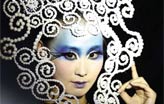
Pret-a-design
China is taking bigger strides to become a force in fashion.
Lasting Spirit
Running with the Beijingers
A twist in the tale
Specials

My China story
Foreign readers are invited to share your China stories.
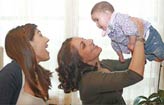
Mom’s the word
Italian expat struggles with learning English and experiences the joys of motherhood again.

Lenovo's challenge
Computer maker takes on iconic brand apple with range of stylish, popular products
